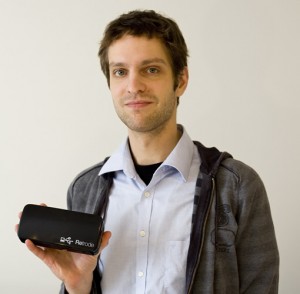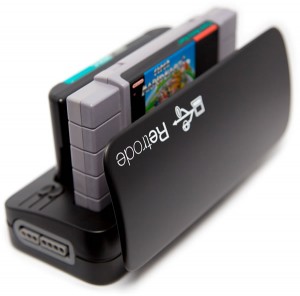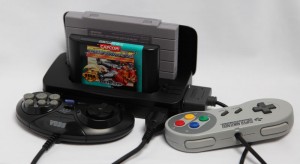 Long after gaming consoles have been discontinued, there are still people working with the technology to implement all kinds of cool things we never got to see when the machines were current. Flash cards and other goodies add a whole new dimension to the retro gaming experience, and there are still plenty of reasons to hold on to that original hardware. The march of new technology has managed to breathe new life into our old consoles, enriching our established gaming experiences and adding new ones to what most people consider to be dead machines.
Long after gaming consoles have been discontinued, there are still people working with the technology to implement all kinds of cool things we never got to see when the machines were current. Flash cards and other goodies add a whole new dimension to the retro gaming experience, and there are still plenty of reasons to hold on to that original hardware. The march of new technology has managed to breathe new life into our old consoles, enriching our established gaming experiences and adding new ones to what most people consider to be dead machines.
Matthias Hullin has undertaken one such project. His Retrode is a device that allows gamers to use their original Genesis and SNES cartridges with a PC emulator. The Retrode can also copy cartridge game saves to and from the computer, and it has a wealth of homebrew potential.
We chatted with Matthias for a spell about the Retrode and the inspiration behind it.
Sega-16: How did you initially come up with the concept for the Retrode?
Matthias Hullin: First, a little story. I never had a console as a kid. In fact, none of my classmates did. Some Game Boys here and there but nothing as awe-inspiring as the SNES they had on display in the mall. It was only in the late ’90s that I discovered emulation, allowing me to catch up on some of that missing piece of my childhood (that’s right, boo hoo indeed). Back then, I didn’t really bother where those “r0mz” came from; after all, they were just another few megs on a 10gig hard drive that was already full of stuff ending on “z.” Later on, as I was cleaning up my drive to legalize my software collection, I had to get rid of all that. This, by the way, was not as much for ethical reasons but rather because I was taking paid jobs as a student. Today I’m a bit of a software developer myself, so I naturally look at those things from a different perspective. Anyway, with my school background in electronics and computer science, I eventually figured I could legalize emulation for myself by getting cheap cartridges on eBay and ripping them to create my own ROM collection.
The second ingredient was me being a science guy. In 2009, around the same time I found about the OpenPandora project, I figured it would be pretty neat to wrap a modern interface (such as USB) around 20-year old technology such as SNES carts, so you could use them on a system like the Pandora. Yet, my research revealed that nobody had ever even tried that. So I set myself that challenge just to see how hard it would be, and to be frank, to have something to show off for once. Turns out it worked… voilà, point shown. That moment is still documented somewhere on the OpenPandora discussion boards.
Now, these two stories only add up to a small fraction of what the Retrode is today. The very moment the project got some exposure on Hack A Day (followed by the usual hype on Engadget, Gizmodo, etc.), I began receiving a tremendous lot of feedback and suggestions from people who thought the idea (and my solution to it) was mighty cool. And so many of the Retrode’s current features originate from community input: SRAM access, controller ports, the Sega slot, use of Dean Camera’s incredibly smooth LUFA framework for the USB part, the config file, or expandability through plug-ins, just to name a few. So you see, it was never really planned that way. Calling it a concept may therefore be a bit too much of a compliment.
Sega-16: Emulation has been around for some time now, offering a very close approximation to the authentic experience. Who is your target audience with this device?
Matthias Hullin: The Retrode doesn’t replace emulation; it just provides an interface for emulators to get their ROM directly from the cart. The “authentic experience,” in my opinion, has to be something like the sum of putting clunky cartridges into a plastic device, being able to use the original controllers, and obviously the love for detail that has resulted into today’s incredible emulators.
As to the target audience, I’m still trying to wrap my head around that. Mind you, the Retrode was not conceived as a product but grew into one due to popular request, so I never really even had to ask myself this question. Except for the controller part, the device doesn’t seem to do anything you couldn’t have for free by googling the ROM for your favorite game. When I talk to users, the single most important factor seems to be the legal grey zone that is the whole ROM business. Many simply prefer a true copy of their own cartridges over a dubious rip from the web. Instead of one of those rare prehistoric cartridge copiers with floppy drive or serial/parallel port, those folks now have a modern alternative that offers true plug-and-play under most OSes and doesn’t actually feel like you’re making a ROM dump.
Another very important thing that WWW downloads can never offer is the possibility to revive your own game saves. If you have invested 500 hours of your childhood into your copy of Zelda 3, you may not want to lose that just because the SRAM battery goes low at some point. In fact, I know of at least two cases of people who have started their own little business, taking battery replacement jobs with data backup using the Retrode. Don’t know how well it works out for them, though.
Sega-16: The device supports firmware updates. What kind of features would you consider adding to it later on?
 Matthias Hullin: The most important item is arguably the support for a growing range of plug-in adapters. Then, I just talked about on-cartridge saves. For the SNES part, it all works fairly well by now, but on the Sega side it is far from complete (only basic SRAM is supported as of now). Don’t let me even begin about the N64 with its zillion different game save types. Besides new features, there are quite a few tiny things on the technical side that I’m still not quite 100% happy with, but may not be of major concern to the user. Some of them may take years to get right.
Matthias Hullin: The most important item is arguably the support for a growing range of plug-in adapters. Then, I just talked about on-cartridge saves. For the SNES part, it all works fairly well by now, but on the Sega side it is far from complete (only basic SRAM is supported as of now). Don’t let me even begin about the N64 with its zillion different game save types. Besides new features, there are quite a few tiny things on the technical side that I’m still not quite 100% happy with, but may not be of major concern to the user. Some of them may take years to get right.
Sega-16: Many gamers who prefer the actual consoles are no doubt questioning the fact that this device still requires an emulator for play. What incentive does the Retrode give over just grabbing a used Genesis/SNES off eBay?
Matthias Hullin: This is something that I don’t usually spend a lot of thought about, but I think it might be interesting to run a little survey. Everyone has to make up their own mind whether the Retrode is for them or not. Bear in mind that people already seem to drop lots of money on Virtual Console versions of games they own (out of curiosity, I once started a poll). At $8 per game (the equivalent of 800 Wii Points), it’s easy to do the math and see when a Retrode starts to pay off.
At the end of the day, however, I guess most users base their decision on a combination of (1) emulation offering a portable alternative to consoles, including for mobile platforms, (2) the original console hardware gradually dying away, and (3) the Retrode being the device that clearly makes you the coolest kid on the block.
There’s another thing that I’m hoping to push forward pretty soon (now that the Retrode 2 is finally out). There is not a lot, but there is a bit of empty space left inside the case. So sometime last spring, I got in touch with a few developers/hackers who would try to squeeze a little ARM-based system (such as the Raspberry Pi or the Gumstix series, just to name a few examples) into that free space. Install a bunch of emulators and a basic menu system, and lo behold, you have a cartridge-based, multi-system miniature console with HDMI out to feed into your 52″ flatscreen TV. How awesome would that be?
Sega-16: This seems like a great alternative for gamers who don’t want to lose their cartridge saves to dying batteries. Swapping saves with friends seems like something that should have been done years ago!
Matthias Hullin: I second every word of that!
Sega-16: What kind of benefit does the Retrode offer programmers and homebrew developers?
Matthias Hullin: Phew. I usually tend to look at the Retrode’s merit in terms of user-friendliness, not so much as a tool for development. However, I have talked to emulator coders who appreciate developing for a piece of gear that integrates nicely with all kinds of operating systems and spits out clean ROM dumps. As you know, those old-school copiers used to produce all kinds of odd formats with proprietary headers, interlaced memory layouts, multi-disk images, etc. I could very well imagine that having to detect and read all those different formats can be quite a nuisance to someone who just wants to write a good emulator.
From the homebrew world, I have for instance been approached by a flash cart manufacturer who is looking for an easy-to-use user interface, something along the lines of, drop a ROM file onto a USB drive, wait, done. We’ll see how well that works since there will be significant technical issues for sure, but it sounds like an intriguing idea.
Sega-16: Reportedly, the Retrode 2 doesn’t work with a few special case games, like Virtua Racing for the Genesis. Other than that, are there any other compatibility issues?
Matthias Hullin: As far as the Genesis platform is concerned, I’m not aware of any, except maybe the lack of EEPROM save and J-cart support (which I’m both planning to look into). The SNES is a bit of a different story, since I’m somewhat hesitant to support co-processors like the S-DD1 and the SA-1 because they could be considered copy-protection mechanisms, which may be illegal to circumvent under DCMA and the likes. The SA-1 also needs to be unlocked by a CIC chip in the console, which the Retrode doesn’t have. More generally speaking, I have found that a 95-98% compatibility rate can easily be achieved, and it’s the remaining few percent that can eat lots and lots of work. Whenever I reach this point, I tend to decide it’s more worthwhile to spend my effort on additional features that will benefit a wider audience.
On the controller side, only standard gamepads (and compatible gear) are officially supported. This is mostly due to hardware constraints; the Retrode’s controller already has quite a few peripherals to talk to with its limited I/O lines, so anything else would require additional hardware to arbitrate between the bus participants.
Sega-16: You offer specifications for adapting the Retrode for other consoles via plug-in adapters, but you don’t actually produce them yourselves. Are you planning any future official hardware support, like for the NES or TurboGrafx-16? What about 32X games?
Matthias Hullin: I have, in fact, offered plug-ins (N64/Game Boys and Atari 2600) for sale in the past, totaling at a few tens of thousands of painstakingly handmade solder joints. Looking back, I’d rather spent this time enjoying a good wine with my lovely wife. 🙂 I do, however, have connectors for N64, the Game Boys, and Master System in stock and am preparing an industrial run of those plug-ins later this year.
Speaking of connectors: the question of whether or not I can offer a certain type of plug-in ALWAYS boils down to being able to source the right connectors. It’s relatively easy to get your hands on a broken Game Gear or Neo Geo Pocket, salvage the connector, and develop yourself a prototype – people have done that, and often that’s enough for me to implement decent firmware support. Then again, you obviously wouldn’t want to do that to 100 Neo Geo Pockets for a batch of 100 plug-ins. So there are only two options: designing and producing custom connectors from scratch (as a rule of thumb, this only begins to pay off around 5k-10k pieces), or finding a supplier who already has the tools on the shelf, or who can adapt existing equipment at a reasonable cost. I was lucky enough to find suppliers for quite a few connector types, but no luck with TG-16 yet. Know a source? I am always grateful for suggestions!
As for the 32X, a few users reported that the Retrode reads those titles just fine. The cartridges just don’t fit the Genesis slot because they’re too fat, and I was reluctant to widen the slot because it would compromise the fit for all other carts. There seem to be two simple fixes to the problem: (1) a screwdriver (just plug the 32X cartridge into the bare Retrode mainboard), or (2) an actual 32X, without power cable, acting as mechanical converter.
Sega-16: Do you see a danger in this device being used for piracy?
Matthias Hullin: Not really. I’m on good terms with all active developers of commercial 16-bit games, and titles such as Beggar Prince and Pier Solar are protected against Retrode dumping anyway. On a different note, I happen to know that there are a few big names from the game development and publishing world among the users of the original Retrode.
 As for the “classic” 16-bit library, all imaginable commercial damage was done a long time ago. Everything has been available on the web for decades now, and if you’re the pirating type, you will likely just go and download your “z” stuff for free. I think we can safely assume no one would seriously consider paying good money for a Retrode just to dump Yoshi’s Island and put it on the web, because they know the laugh would be on them. Also, I’m pretty explicit in the usage notes that if you use the Retrode for piracy, I will personally go and tell Santa you’re being a naughty kid.
As for the “classic” 16-bit library, all imaginable commercial damage was done a long time ago. Everything has been available on the web for decades now, and if you’re the pirating type, you will likely just go and download your “z” stuff for free. I think we can safely assume no one would seriously consider paying good money for a Retrode just to dump Yoshi’s Island and put it on the web, because they know the laugh would be on them. Also, I’m pretty explicit in the usage notes that if you use the Retrode for piracy, I will personally go and tell Santa you’re being a naughty kid.
The only exception to what I just said may be rarities and prototypes for which no dump is circulating yet. Folks, please be wise and resist the urge. Any illegal activities that can somehow be traced to the Retrode will not only endanger the existence of my little project. I’ll say it again: the fate of your very butt rests in Santa’s sole discretion.
Sega-16: What’s next for you and the Retrode?
Matthias Hullin: As always. You tell me. That’s how the project works 🙂
For more information on the Retrode, visit the website. Our thanks to Matthias Hullen for chatting with us.

Pingback: ‘Retrode’ stöpselt Nintendos SNES-Controller ans iPad (+ Video) – iPhoneBlog.de
I like it and after reading this interview I ran on over to http://stoneagegamer.com/ to buy it but I stopped when I saw the $90 USD price tag.
Once this has Raspberry Pi I’ll be all over it.
Great looking product. I really do like it.